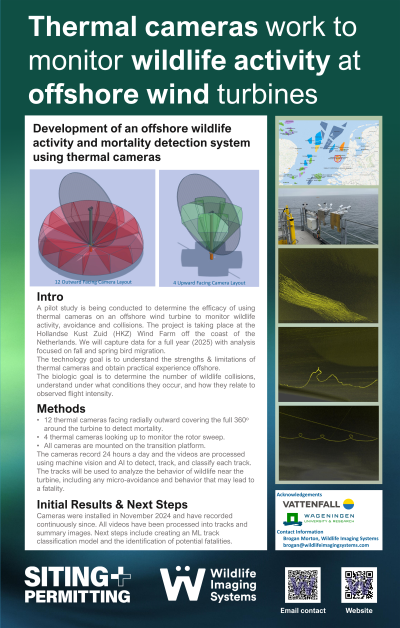Development of an offshore bird and bat activity and mortality detection system


Brogan P. Morton, MSME, MBA (he/him/his)
Founder & CEO
Wildlife Imaging Systems
HINESBURG, Vermont
Poster Presenter(s)
Wildlife Imaging Systems is collaborating with Vattenfall and Wageningen Environmental Research to study the use of thermal cameras in the offshore environment. The intent of the project is to study the efficacy of using thermal cameras around an offshore wind turbine to monitor wildlife micro-activity, micro-avoidance and collisions with the turbine blades in the rotor swept zone, as well as direct mortality occurring in the offshore environment.
The project is taking place at the Hollandse Kust Zuid (HKZ) Offshore Wind Farm in the North Sea off the coast of the Netherlands. This pilot study is deploying sixteen thermal cameras. Twelve of sixteen will be used to measure direct mortality caused by the wind turbine. They will be mounted on the railing of the transition platform and their field of view will be directed radially outward away from the turbine tower covering the full 360° around the base of the tower and operate for 24 hours a day. The goal of these cameras is to detect a falling object after a direct fatality.
The additional four cameras will be mounted to the railing of the transition platform, but will be looking up toward the nacelle, monitoring the rotor swept zone. The four cameras will be positioned such that they will each be monitoring a side of the turbine, resulting in 360° coverage of the rotor swept zone. All camera data will be processed using state-of-the-art machine vision and AI to automatically detect, track, and classify each detection. The tracks will then be used to analyze the behavior of wildlife near the turbine, including any micro-avoidance seen and any behavior that may lead to a fatality. The system is scheduled to be installed in 2024, so the poster will present the first data that have been analyzed from the system.
